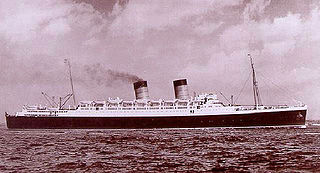
RMS Mauretania was a British ocean liner that was launched on 28 July 1938 at the Cammell Laird yard in Birkenhead, England, and was completed in May 1939. She was one of the first ships built for the newly formed Cunard-White Star company following the merger in April 1934 of the Cunard and White Star Line. On the withdrawal of the first Mauretania in 1935, to prevent a rival company using the name and to keep it available for the new liner, arrangements were made for the Red Funnel paddle steamer Queen to be renamed Mauretania in the interim.

CP Ships was a large Canadian shipping company established in the 19th century. From the late 1880s until after World War II, the company was Canada's largest operator of Atlantic and Pacific steamships. Many immigrants travelled on CP ships from Europe to Canada. In 1914 the sinking of the Canadian Pacific steamship RMS Empress of Ireland just before World War I became largest maritime disaster in Canadian history. The company provided Canadian Merchant Navy vessels in World Wars I and II. Twelve vessels were lost due to enemy action in World War II, including the RMS Empress of Britain, which was the largest ship ever sunk by a German U-boat.

RMS Empress of Britain was a transatlantic ocean liner built by the Fairfield Shipbuilding and Engineering Company at Govan on the Clyde in Scotland in 1905–1906 for Canadian Pacific Steamship (CP). This ship – the first of three CP ships to be named Empress of Britain – regularly traversed the transatlantic crossing between Canada and Europe until 1923, with the exception of the war years. Empress of Britain was the sister ship of RMS Empress of Ireland, which was lost in 1914.
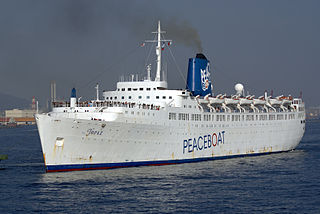
RMS Empress of Britain was a transatlantic ocean liner built by Fairfield Shipbuilding at Govan on the Clyde in Scotland in 1955-1956 for Canadian Pacific Steamships (CP). This ship — the third of three CP vessels to be named Empress of Britain — regularly traversed the trans-Atlantic route between Canada and Europe until 1964, completing 123 voyages under the Canadian Pacific flag.

HMS Montclare (F85) was a British ocean liner that was commissioned into the Royal Navy as an armed merchant cruiser in 1939, converted into a destroyer depot ship in 1944 and a submarine depot ship in 1946. She was decommissioned in 1954 and scrapped in 1958.

RMS Empress of Australia was an ocean liner built in 1913–1919 by Vulcan AG shipyard in Stettin, Germany for the Hamburg America Line. She was refitted for Canadian Pacific Steamships; and the ship – the third of three CP vessels to be named Empress of China – was renamed yet again in 1922 as Empress of Australia.

USS DeKalb (ID-3010) was the German mail ship Prinz Eitel Friedrich that served during the early part of the First World War as an auxiliary cruiser (Hilfkreuzer) in the Imperial German Navy and later after the US entry into the war, as a US Navy troop ship. Post war she returned to civilian service as the US transatlantic liner SS Mount Clay.

RMS Sylvania was an ocean liner built in 1957 by John Brown & Co (Clydebank), in Glasgow, for the United Kingdom-based shipping company Cunard Line. She was the last Cunard Line vessel built specifically for transatlantic crossings. The ship was later heavily rebuilt as a cruise ship, and sailed under the names SS Fairwind, SS Sitmar Fairwind, SS Dawn Princess and SS Albatros before being scrapped in 2004. She was renamed SS Genoa for her last voyage.
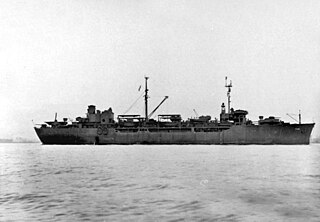
USS General J. R. Brooke (AP-132) was a General G. O. Squier-class transport ship for the U.S. Navy in World War II. She was named in honor of U.S. Army general John Rutter Brooke. Decommissioned in 1946, she was sold privately in 1964 and renamed SS Marymar, and was scrapped in 1979.

RMS Empress of Canada was an ocean liner launched in 1960 and completed the following year by Vickers-Armstrongs of Walker, Newcastle upon Tyne, England for Canadian Pacific Steamships Ltd. This ship, the third CP vessel to be named Empress of Canada, regularly traversed the transatlantic route between Liverpool and Canada for the next decade. Although Canadian Pacific Railways was incorporated in Canada, the Atlantic liners were owned and operated by the British registered subsidiary Canadian Pacific Steamships Ltd. and were always British flagged and manned and therefore Empress of Canada was not the flagship of the Canadian Merchant Marine.

RMS Empress of China was an ocean liner built in 1890-1891 by Naval Construction & Armament Co., Barrow, England for Canadian Pacific Steamships (CP). This ship—the first of three CP vessels to be named Empress of China—regularly traversed the trans-Pacific route between the west coast of Canada and the Far East until she struck an underwater reef and sank in Tokyo harbour in 1911.

RMS Empress of India was an ocean liner built in 1890-1891 by Naval Construction & Armaments Co, Barrow-in-Furness, England for Canadian Pacific Steamships. This ship would be the first of two CP vessels to be named Empress of India, and on 28 April 1891, she was the first of many ships named Empress arriving at Vancouver harbor.

RMS Empress of Scotland, originally SS Kaiserin Auguste Victoria, was an ocean liner built in 1905–1906 by Vulcan AG shipyard in Stettin for the Hamburg America Line. The ship regularly sailed between Hamburg and New York City until the outbreak of war in Europe in 1914. At the end of hostilities, re-flagged as USS Kaiserin Auguste Victoria, she transported American troops from Europe to the United States. For a brief time Cunard sailed the re-flagged ship between Liverpool and New York.
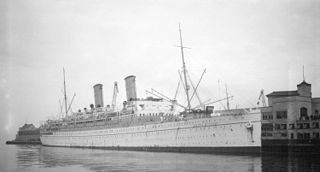
RMS Empress of France, formerly SS Alsatian was an ocean liner built in 1913-1914 by William Beardmore and Company at Glasgow in Scotland for Allan Line. In total, the ship's service history encompasses 99 trans-Atlantic voyages, 5 trans-Pacific voyages, and 8 other cruises in addition to her war service.

RMS Carinthia was an ocean liner built in 1956 as one of the four Saxonia class ships. She sailed for Cunard Line from her completion until 1968 when she was sold to Sitmar Line, rebuilt into a full-time cruise ship and renamed SS Fairsea. She sailed with Sitmar until 1988, when Sitmar was sold to P&O. She was renamed SS Fair Princess and sailed for Princess Cruises and P&O Cruises until 2000. She was then sold to China Sea Cruises and renamed SS China Sea Discovery. In 2005 or 2006 she was scrapped in Alang, India.

SS Statendam was a transatlantic ocean liner that was launched in Ireland in 1898 for Holland America Line. She was the first of several ships in the company's history to be called Statendam. She was NASM's first ship of more than 10,000 GRT, and she was the largest ship in the company's fleet until Potsdam was completed in 1900.

SS Lapland was a steam ocean liner built in Ireland for the Belgian Red Star Line, as Red Star's flagship, similar in appearance to the fellow liners SS Samland, SS Gothland and SS Poland, but far larger. She was a half sister to White Star Line's "Big Four." They were similar in many ways, such as the island bridge, 4 masts, 2 funnels. But Lapland had a less luxurious interior.

RMS Empress of England was an ocean liner built in 1956-1957 by Vickers-Armstrongs, Newcastle upon Tyne, United Kingdom for the Canadian Pacific Steamships. The ship was launched in 1956; and she undertook her maiden voyage in 1957 and was a near identical sister ship to Empress of Britain.
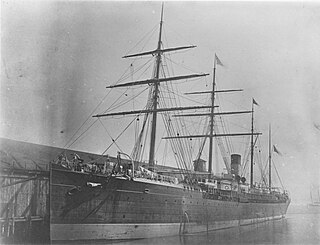
SS Arabic was a steamship of the White Star Line and its first steel-hulled vessel. Like her predecessors, she was built by shipbuilders Harland and Wolff of Belfast.
SS Melita was one of a pair of transatlantic steam ocean liners that were built in the United Kingdom, launched in 1917 and operated by Canadian Pacific until 1935. Her sister ship was Minnedosa.





















